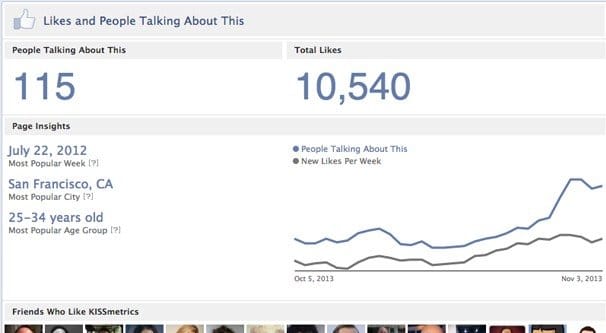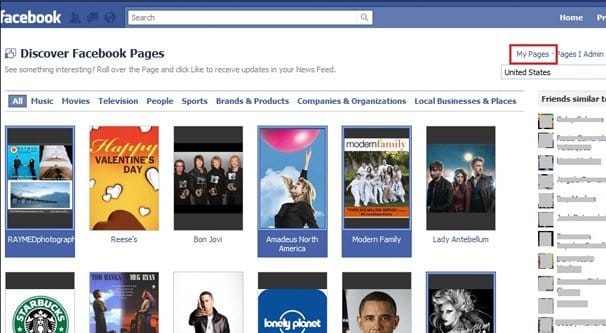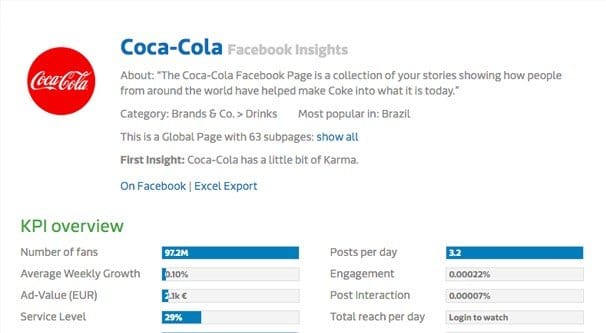 Written by ContentPowered.com
Written by ContentPowered.com
You and your competitor are both about the same. You both offer, say, red gadgets. Yours are Great Brand Red Gadgets, while theirs are Meh Brand Reddish Gadgets. You’re pretty sure you have the advantage in product, but it’s not by a lot. You know that you sell around 100,000 gadgets a year, and you know from their sales numbers that they sell around 98,000 a year. Again, comparable, but a little worse than you. You know they have similar prices, similar profits, and similar audiences. You’ve been competing for years.
So why is it, when you take a look at their Facebook page, they have 50x the fans you do? Where did they all come from?
Well, there are three possible ways in general that a competitor in a similar niche could be dramatically out-performing you.
- They purchased a huge number of fake followers.
- They’re aggressively buying followers through ads, first or third party.
- They’re simply taking better advantage of Facebook than you.
The first one is easy to identify. Checking out a profile for fake followers is simple, and we’ve written about it before. To that end, I’m going to gloss over most of the details.
The second and third, meanwhile, are more detrimental to you. If they’re aggressively – and successfully – buying legitimate followers, you’re at a disadvantage. You need to start doing the same thing, but you’re already behind. Unless you have a significant budget, you won’t be able to catch up. A comparable budget only gets you the same growth rate they have, or perhaps even worse, because they’re competing for the same ad spots.
Meanwhile, if they’re taking better organic advantage of the site, you’re going to have a lot of work ahead of you to cut into that share. You’re going to need to one-up them, and it may or may not be hard, depending on how much work they’ve put into it. If they’re complacent in their lack of competition, you may be able to surprise them and poach their followers before they can react.
So, let’s talk about ways you can figure out what their strategy is and how you can do it better, shall we? With a little luck and a lot of work, you can rival or surpass them.
Older Techniques
Before we begin, I’m going to go over a couple of older techniques that are still prevalent in articles, but no longer work. Don’t try to use these; you’ll either encounter frustrating barriers, or you’ll get yourself banned.
- Social Lead Freak, as mentioned on a Quicksprout article, is one of several pieces of software that were able to access hidden data on Facebook and scrape the user IDs of the people who follow a given page. Facebook has made two changes to their site that eliminate the viability of this method. The first is simply banning anyone who uses a bot scraper like this. It’s technically scraping data you don’t have the rights to access, and thus is contrary to the terms of service. The second is by making it significantly harder to access the data in the first place; the bots often no longer work.
- Using the link.getStats console. This used to be a test console you could use by plugging in the ID of the page you’re checking, then testing an “app” that pulls stats. Essentially, it would pretend you’re testing an app and pull data, but it pulled real, live data. Since Facebook moved to the Rest API, this test console no longer exists.
- Using the Graph API to pull data. This is the modern version of using the test console to pull data. It worked for a while, but it doesn’t work now, because Facebook plugged in a gate. You now have to have an access token to access data, and in order to get that token, you need approval. You can get it, and this method still works – you can read about it here – but getting the token is going to be more work than its worth.
Browse Public Followers
For much of what I’m going to talk about, I’m going to use the public page for Coca-Cola as an example. If you want to follow along, you can find it here.
On this page, click the follower number on the left. This is where it shows that 97 million people like Coke and however many of your friends – in my case 13 – like them. When you click that, you see some stats. It’s not much – not nearly as much as it used to be – but you can see a graph that shows growth over the last week. Look for anything out of the ordinary here. Coke’s graph is relatively normal. If you see a sharp increase or decrease of a significant number, you can suspect that they’ve been buying fake followers, who all follow at roughly the same time because they’re all bots controlled by one person.
While you’re at it, look at engagement rates. If your competitor has a ton of followers but no engagement, it’s a sign that they bought all their followers and aren’t actually getting any value out of them. It’s only when they have engaged followers that you have to be wary.
Browse Public Posts
Next, scroll down a bit and check out the left sidebar box labeled “visitor posts.” This is where any post made by someone else, posted to Coke’s wall, is stored. These aren’t shown on the timeline, which would be open to abuse. Can you imagine? If I could post my own brand message on Coke’s wall and get it in front of their 97 million followers you could bet I’d do it in a heartbeat. It’s no wonder it’s hidden off to the side.
The visitor posts section will show you public sentiment and interaction with the brand. Coke largely ignores their visitor posts, and with good reason. A lot of them are spam or unrelated customer service queries that should be taken elsewhere.
- A post asking them to stop having their handles break.
- A post asking them to bottle coke and sprite mixed.
- A post asking them to bring back a promotion that ended.
- A post asking them to change their recipe.
A lot of them are like this. Demands made of a company that has almost 100 million people to watch just on that site alone. Comments of complete irrelevance. Most of it is just noise. Of those that remain, you have both positive and negative comments.
The positive comments are worth watching because they give you an idea of what the brand in question is doing right. Are they inspiring loyalty? Are they running contests with posts as the submission method? Are they actively engaging with the people who post to their wall? Figure out what is drawing in the positive engagement, and see if you can emulate it.
The negative comments are just as valuable, because they can identify weaknesses. If the business in question has a lot of irate customers posting about their problems, and those posts are left unanswered, it’s an opportunity for you. You can target those people in ads and try to reach them with messaging directly about the issue at hand. If everyone who likes your competitor is fed up that their Gadgets break after three months, you can advertise to their audience and use an ad that conveys that your Gadgets are known to last for over a year. You’re addressing a problem you know they have, but that they don’t know you know about.
Similar Pages
Facebook’s search bar is actually surprisingly robust. One trick you can use is typing in a specific sort of query. For example, “pages liked by people who like X” will get you a list of the pages that are most liked by the people who like brand X. In the case of Coke, you have to actually use the name of the page, which is CocaColaUnitedStates, not just Coke or Coca-Cola.
This search will show you what other pages are most commonly liked, and will allow you to see what sorts of interests your competitors’ fans have. You can use this as additional information to target them. This is, incidentally, another way you can identify if a page has a majority of fake likes. If you’re seeing a random bunch of no-name pages there, particularly bollywood or middle eastern pages, you are probably seeing clickfarm users who have thousands of likes, many of which are the same.
You can also just do “people who like brand X” as a search, but it’s not going to show you everyone. It’s generally going to start by showing you the people who like X but also like or are friends with you. It will then show second degree connections, the people who like X and who are friends with the people who like you. It spirals out from there, and will never show you the full audience.
Other searches include things like “Groups of people who like brand X” or “favorite interests of people who like brand X”
Poacher Advertising
This one is a bit of a dirty trick, but pretty much everyone uses it and it’s not against the terms of Facebook at all. Essentially, what you’re going to do is run paid ads through Facebook’s ads system, and you’re going to use a specific interest targeting segment. This is, by the way, the prime opportunity to use the information you’ve gotten about the weaknesses in your competition. If they’re having a lot of issues with a product, you can advertise to their audience about how your product doesn’t have those issues.
When you make an ad, you’ll get to the targeting window after you’ve put in basic information. The first thing to do is set geographic targeting. Always set this! If you’re opening your ad up to non-geographically-relevant users, you’re going to find your budget goes down the drain and you get nothing of value out of it. How broad or narrow your geographic targeting is will depend on your brand presence. If you’re a brand like Coke, something like “the entire United States” is fine. Coke has other sub-pages for different countries. If you’re a small local business, narrowing down to just your county or city will be fine.
The trick is the “precise interests” box. This is where you plug in the specific page name of your competitor. CocaColaUnitedStates would become Coca-Cola, and would expose your ad to everyone who likes Coke. The same goes for whatever brand you want to target. Facebook will give you an estimated reach, and you can set your budget appropriately.
Fanpage Karma
Fanpage Karma is a web app that shows you a lot of data you can’t otherwise access on your own, mostly pulled from the Graph API and from social analysis. When you run a page through it, you get to see their about, their category, their most popular country, their subpages, and their key performance indicators. Coke, for example, is most popular in brazil, has low average weekly growth, miniscule engagement, but a fast response time and a high number of posts per day.
Some of the most important data here comes from the other tabs. The “times and types” tab shows you an analysis of when and how often the brand posts. The days of the week and the times of day, as sorted by engagement, are both excellent metrics to watch. You can use this further for your ads targeting to determine when you should be running those ads and making organic posts.
The influencers tab shows you the most influential people engaging with the brand. This will show you some of the people you might want to directly reach out to poach, or at least monitor for opportunities to supplant. It’s tricky to use this well, so be cautious. Most notably, this tab also shows what other pages have the same active fans, which can show you relationships.
From there, it’s all about refining your ads and increasing your budget until you get to the point you’re trying to reach. Ads don’t come cheap – or rather, they do, but the engagement you want in bulk is harder to get. You need to strive to maintain your position as the better brand, so you have backing to your claims.



